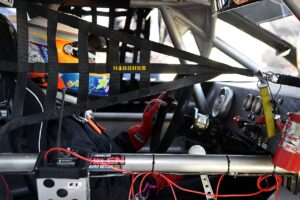No products in the cart.
History
How Technology Impacted Racing: Shaping the NASCAR Cup Series
 How Technology Impacted Racing: Shaping the NASCAR Cup Series
How Technology Impacted Racing: Shaping the NASCAR Cup Series
In the high-octane world of NASCAR, speed, strategy, and precision are everything. But what happens when technology is thrown into the mix? The days of racing on pure mechanical intuition are long gone. Today’s drivers and teams have access to sophisticated tools like telemetry, wind tunnel testing, and data analytics that redefine what it means to be fast on the track. Let’s dive into how these technological advancements have impacted racing in the NASCAR Cup Series.
The Role of Aerodynamics: Engineering Speed
One of the most significant ways technology has altered NASCAR is through aerodynamics. Every component of a car—from the spoiler to the body shape—is meticulously designed to minimize air resistance and maximize speed. In the early days of NASCAR, cars were far less aerodynamically efficient. They were largely stock cars with minimal modifications, and their ability to cut through air wasn’t a huge concern.
Enter wind tunnel testing.
Wind tunnels are used to simulate the flow of air over a car’s body at high speeds. This allows engineers to see how air will interact with the car on the track, helping them find ways to reduce drag and increase downforce. With optimal aerodynamics, cars become faster, more stable, and less prone to losing traction in tight corners or high-speed straightaways.
Advanced Telemetry: The Car Talks Back
Imagine your car being able to communicate with you while you drive, telling you exactly how it’s performing in real time. This is what telemetry offers to NASCAR teams. Telemetry systems collect a massive amount of data from various sensors embedded in the race car. These sensors monitor everything from tire pressure to engine temperature to fuel efficiency. The data is then transmitted to the crew chief and race engineers in real-time, allowing them to make critical decisions during a race.
For example, telemetry can alert the team if a tire is losing pressure or if the engine is overheating, giving them a heads-up before a catastrophic failure happens on the track. It can also help teams fine-tune their pit stop strategies, ensuring that the car is refueled or fitted with new tires at just the right time.
This level of insight wasn’t available in the early days of NASCAR. Back then, drivers relied almost entirely on their gut instinct and mechanical feel to gauge how their car was performing. Now, telemetry provides precise, real-time feedback, giving drivers and teams a significant strategic edge.
Data Analytics: Winning by the Numbers
If telemetry is the heart of NASCAR technology, data analytics is the brain. After each race, teams comb through mountains of data collected from telemetry, as well as lap times, track conditions, and weather patterns. This data is analyzed to identify patterns and trends, helping teams predict how their car will perform under different conditions.
For instance, by analyzing tire wear data, a team can determine the optimal number of laps before a tire change is necessary, which could shave valuable seconds off a pit stop. Analytics can also be used to study a competitor’s strategy, identifying their strengths and weaknesses on specific tracks. This data-driven approach allows teams to tailor their racing strategies for each race, ensuring that they have the best possible chance of victory.
It’s no longer just about who has the best driver or the fastest car; it’s about who has the best data. Racing has become a chess match where every decision is informed by analytics, and the team that can best interpret the numbers often comes out on top.
Simulators: The Virtual Race Track
Another technological advancement that has revolutionized NASCAR is the use of racing simulators. These sophisticated systems allow drivers to practice on virtual versions of real-world tracks, giving them the chance to learn every turn, bump, and straightaway without ever leaving the garage.
Simulators replicate the driving experience down to the tiniest detail, from the way the steering wheel feels to how the car reacts to different track surfaces. This helps drivers hone their skills and refine their techniques before race day. Additionally, simulators provide a risk-free environment for drivers to experiment with different strategies, such as how to approach a tricky corner or when to brake during a high-speed turn.
In essence, simulators allow drivers to race hundreds of laps without burning through fuel or tires, providing them with a cost-effective, high-tech practice tool.
Engine Technology: Powering the Future
While aerodynamics, telemetry, and data analytics have garnered much of the spotlight, engine technology has also undergone significant improvements. NASCAR engines today are marvels of engineering, designed for maximum power output and reliability. Modern engines feature advanced materials, precision engineering, and electronic control units (ECUs) that help teams optimize performance during races.
The evolution of NASCAR engines has allowed for greater power while maintaining the reliability needed to endure the grueling demands of a race. Engine development is one of the most closely guarded secrets in NASCAR, as teams are constantly looking for ways to eke out more horsepower without violating the sport’s strict regulations.
Technology’s Impact on Racing Strategy
All of this technology adds up to one crucial thing: smarter racing strategies. Teams can now anticipate how their car will perform under specific conditions, adjust on the fly, and make data-driven decisions that can mean the difference between winning and losing. Technology has added layers of complexity to a sport once dominated by raw instinct and mechanical skill.
While the heart of NASCAR will always be about drivers pushing themselves and their machines to the limit, the infusion of technology has turned racing into a finely-tuned science. The faster, more efficient, and more data-driven teams are, the better their chances of taking home the checkered flag.



